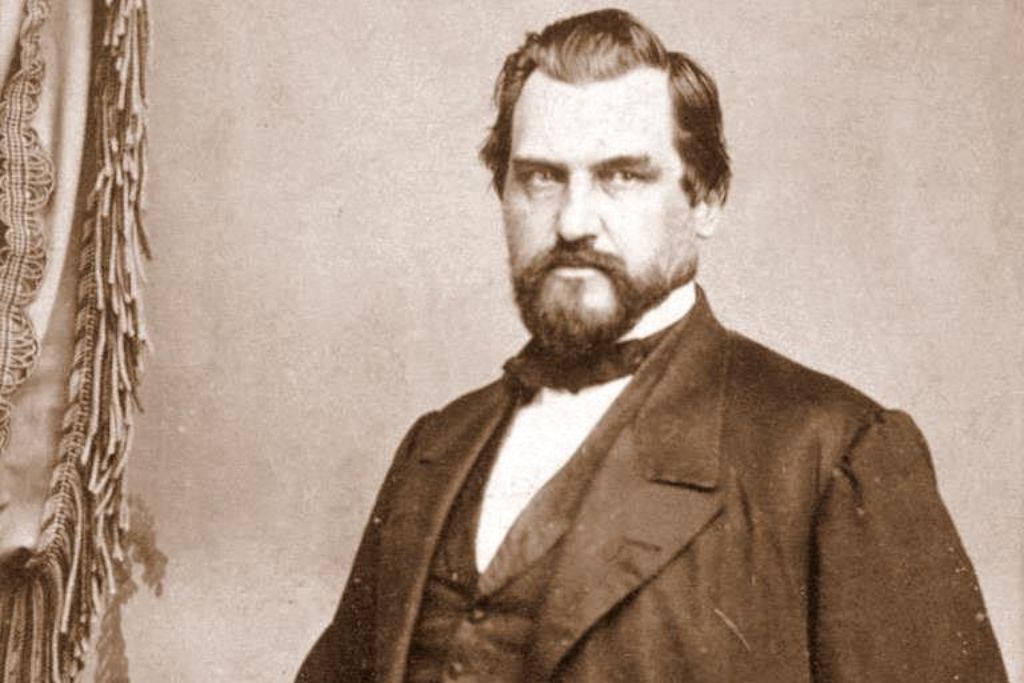
Today, Stanford University is arguably the best university for aspiring entrepreneurs, with its alumni including Larry Page, Sergey Brin and Elon Musk. Yet few know the story of its founder, Leland Stanford, who built a business empire unlike any other!
Most famous for the railroad empire that could rival Cornelius Vanderbilt’s, at various points, Stanford also had holdings in the finance and shipping industries, as well as large winery and horse breeding operations too, all of which made him a billionaire by today’s standards.
Early Life
Amasa Leland Stanford was born on March 9 1824 in Watervliet, New York. The fifth of eight children born to wealthy farmer Josiah Stanford and his wife, Elizabeth Phillips, Stanford’s earliest known ancestor, Thomas Stanford, had moved to America from England in the late 17th century.
Thomas Stanford had initially settled in the town of Charlestown, Massachusetts (now a neighborhood of Boston), with his descendants moving to the Mohawk Valley of New York around 1720, where they lived for the next 100 years or so.
As was common at the time, many of Leland’s siblings were named after famous people:
His younger brother, DeWitt Clinton Stanford (born 1826), was named after DeWitt Clinton, then the Governor of New York. Another brother, Jerome Bonaparte Stanford (born 1829), was named after Napoleon’s older brother and the former King of Spain.
Both men were admired by Leland’s father.
Growing the son of a prosperous farmer, a young Leland spent much of his childhood on the farms his father owned in the Kisha Kill and Roessleville areas of Watervliet, where his father put Leland and his brothers to work for the family’s benefit.
This was also designed to teach the Stanford children the necessity for a strong work ethic.
Yet it wasn’t all hard work and no play, unlike many boys of the era, Leland received a formal education at the local public school between 1830 and 1836, and was then tutored at home between 1836 and 1839.
That year, at age 15, Leland was sent halfway across the state to the prestigious Clinton Liberal Institution preparatory school in the village of Clinton, New York. Graduating in 1841, Stanford enrolled at Cazenovia Seminary (now College), studying law.
Graduating in 1845, Stanford found work as a lawyer at Albany, New York-based law firm Wheaton, Doolittle and Hadley whilst studying for the bar. Passing the bar exam in 1848, Leland Stanford moved westward to Wisconsin.
Here, he started a law practice with close friend and fellow lawyer, Wesley Pierce.
Having their offices in center of Port Washington, Wisconsin, Leland’s father elected to help his son’s fledgling firm by donating an extensive law library to the new firm, often said to have been one of the finest in the state.
First Business Ventures
When his law offices burned down in 1852, destroying the extensive law library his father had donated, Leland was understandably distraught. With his offices burning down, Leland seemed to lose all interest in practicing law.
Now wanting a fresh start, Leland followed his brothers (who’d moved several months prior) to California, which was then experiencing a gold rush, luring people from all over the Union with the prospect of striking it rich.
Though they were undoubtedly tempted, Leland and his brothers decided the best way to strike it rich in California was not by searching for gold. Instead, it was selling essential goods to the miners for a huge markup.
Setting up their store in Michigan City, California (now known as Michigan Bluff) the Stanford brother’s store sold everything from food to water to gold pans: everything a miner could or would ever need.
Being surrounded by places prospective miners frequently search for gold at, it wasn’t long until Leland’s store was turning a hefty profit. But it wasn’t just making a profit, it made each of the brothers millionaires by today’s standards.
Eventually, the store began expanding to multiple locations, sending Leland’s brother, Charles, back home to New York to run the eastern division of the company and take care of their elderly parents.
Beginnings in the Railroad Industry
Self-sufficient within only a few years, in 1856, Leland Stanford and his wife, Jane (the daughter of an Albany merchant who he’d married in 1850), moved to Sacramento, the capital city of California, to pursue other business ventures.
Establishing himself as one of the richest businessmen in California and a pillar of the local community, almost everyone in Sacramento knew the name “Leland Stanford”.
In 1861, Stanford was introduced to railroad engineer Theodore Judah, who was looking for investors for what he called the Central Pacific Railroad, which was to form the western portion of the First Transcontinental Railroad.
Excited about the prospect of connecting Sacramento to the East Coast via the Sierra Nevada and Rocky Mountains, Leland Stanford was one of four wealthy California businessmen to put up the money for the project.
Officially incorporated on June 28 1861, the other three businessmen interested in Judah’s proposition were Charles Crocker, Mark Hopkins and Collis P. Huntington, collectively dubbed by the press as the “Big Four” (or simply “The Associates among themselves).
Named the company president over Judah (which he was quite bitter about, having to settle with being vice-president), Leland had the final say-so on any construction decisions – a fact that greatly annoyed his business partners.
Though a maverick when it came to running mercantile ventures, when it came to building a fully functioning railroad over hazardous territory like the Sierra Nevada and Rocky Mountains, Leland was rather inept, leaving his work for his subordinates to do.
However, once the railroad had been laid down beyond the mountains, Stanford lived up to his reputation as a maverick.
Becoming closer with David Hewes, who’d helped them clear much of the land the railroad was built on, when the Mormons in Utah made a fuss about the railroad cutting across their land, Leland traveled personally to reassure them that their lives wouldn’t be disturbed.
And Leland kept to his word.
Construction finished in May 1869 and Leland, as the CPPR’s President, was present at the ceremonial driving of the “Last Spike” (later called the “Golden Spike) at Promontory, Utah.
All four of the CPPR’s initial investors later became multimillionaires by contemporary standards due to their association with the railroad.
Financial Industry
Expansion of Railroad Interests
Other Business Ventures
Political Career
Death
Legacy
How Can I Replicate What Leland Stanford Did?
What Can we Learn From Leland Stanford?
Though he was born nearly 200 years ago, and has been dead for well over a century, the life of business magnate Leland Stanford is surprisingly more relevant than you’d first think.
Not only can it teach you about how to start your own business, and more importantly, how to make it successful, but it can also teach you about life in general…
Education is Key
Don’t Forget to Give Back
Always Diversify
Make Powerful Friends
Has the life of Leland Stanford inspired you? How will you try and replicate him? Tell me in the comments!

1 Comment
Jimrumma · March 2, 2022 at 10:37 pm
Really interesting post! Leland Stanford was truly an amazing business magnate. I never knew that Stanford was named for his son and not him! Keep up the good work!
Comments are closed.